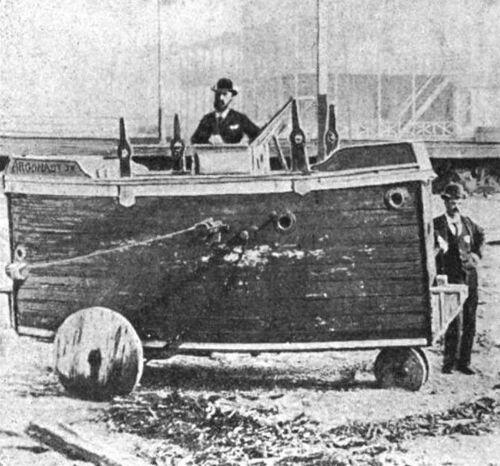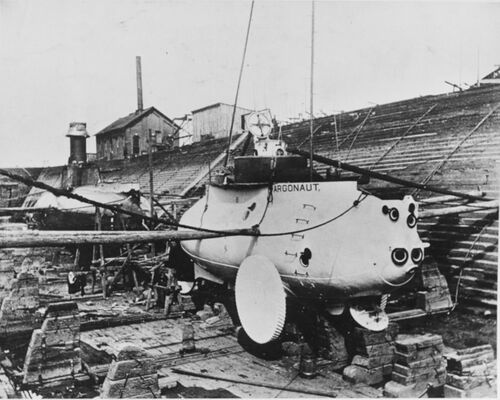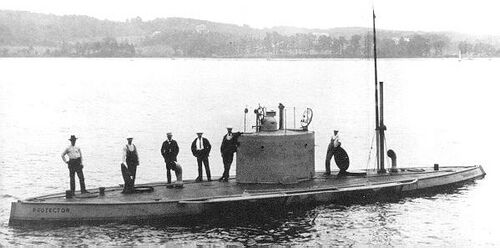Simon Lake non-Navy Submarines: Difference between revisions
Pbcjohnston (talk | contribs) Added captions |
Pbcjohnston (talk | contribs) mNo edit summary |
||
| Line 6: | Line 6: | ||
<div style="text-align: justify;"><span style="color:#00008B">Lake was highly influenced in his work by the Vernian ideals of submarine operations. He saw submarines chiefly in the exploration role, fulfilling a military function only as an aside. He saw his submarines as sailing on the surface to their operating area, diving to the bottom, then rolling along on wheels to a worksite. Suited divers would then emerge from a hatch in the bottom and perform the boat's mission. He was quite stubborn in this vision, and it drove much of his design work. Unfortunately, this vision was not shared by his primary customer, the United States Navy, who saw submarines primarily as a weapon, a mobile minefield upon which an attacking enemy force could be impaled on.</span><br><br> | <div style="text-align: justify;"><span style="color:#00008B">Lake was highly influenced in his work by the Vernian ideals of submarine operations. He saw submarines chiefly in the exploration role, fulfilling a military function only as an aside. He saw his submarines as sailing on the surface to their operating area, diving to the bottom, then rolling along on wheels to a worksite. Suited divers would then emerge from a hatch in the bottom and perform the boat's mission. He was quite stubborn in this vision, and it drove much of his design work. Unfortunately, this vision was not shared by his primary customer, the United States Navy, who saw submarines primarily as a weapon, a mobile minefield upon which an attacking enemy force could be impaled on.</span><br><br> | ||
<div style="text-align: justify;"><span style="color:#00008B">To aid in his quest to sell submarines to the USN, Lake also developed the idea of submerging a submarine on a level plane, with a zero angle (sometimes called "even keel diving"). Holland used stern mounted diving planes and the power of the propeller to angle the boat downward and push it under, with surfacing being the opposite operation. Lake felt that this was too dangerous. If the crew lost control of the angle the boat could quickly exceed its hull strength depth and be destroyed. He emphasized the use of multiple sets of planes mounted amidships to ease the boat downward while maintaining a zero angle.</span><br><br> | <div style="text-align: justify;"><span style="color:#00008B">To aid in his quest to sell submarines to the USN, Lake also developed the idea of submerging a submarine on a level plane, with a zero angle (sometimes called "even keel diving"). Holland used stern mounted diving planes and the power of the propeller to angle the boat downward and push it under, with surfacing being the opposite operation. Lake felt that this was too dangerous. If the crew lost control of the angle the boat could quickly exceed its hull strength depth and be destroyed. He emphasized the use of multiple sets of planes mounted amidships to ease the boat downward while maintaining a zero angle.</span><br><br> | ||
<div style="text-align: justify;"><span style="color:#00008B">Although a brilliant engineer, Lake possessed two qualities that tended earn him scorn and mistrust rather than the praise and lucrative USN contracts that he desired. He was quite stubborn in his beliefs about how submarines should be operated, and he refused to tolerate any challenge to those ideals. This stubbornness caused him to be quite outspoken when things did not go his way, earning him a reputation as a pariah. Secondly, despite his acknowledged talent as an engineer, Lake was a poor businessman and organizer. His shipyard was chronically underfunded and poorly managed, and thus his profit margin was quite low, and at times non-existent. Despite numerous attempts, Lake was unable to sell a submarine to the USN until 1912. He had been marginally more successful in the overseas market, but he struggled with the USN until this point. The acceptance of his [[G-1|'''submarine G-1''']] seemed to clear the log-jam for a bit, and over the next 10 years he sold a number of boats to the USN. However, the Navy never really liked his designs | <div style="text-align: justify;"><span style="color:#00008B">Although a brilliant engineer, Lake possessed two qualities that tended earn him scorn and mistrust rather than the praise and lucrative USN contracts that he desired. He was quite stubborn in his beliefs about how submarines should be operated, and he refused to tolerate any challenge to those ideals. This stubbornness caused him to be quite outspoken when things did not go his way, earning him a reputation as a pariah. Secondly, despite his acknowledged talent as an engineer, Lake was a poor businessman and organizer. His shipyard was chronically underfunded and poorly managed, and thus his profit margin was quite low, and at times non-existent. Despite numerous attempts, Lake was unable to sell a submarine to the USN until 1912. He had been marginally more successful in the overseas market, but he struggled with the USN until this point. The acceptance of his [[G-1|'''submarine G-1''']] seemed to clear the log-jam for a bit, and over the next 10 years he sold a number of boats to the USN. However, the Navy never really liked his designs. They were mechanically and operationally complex, they had features that the Navy didn't like such as midships diving planes and watertight superstructures, and because of his poor management his boats were usually very late in delivery and lacking in construction quality. Finally tired of his business drama, the USN awarded Lake no more contracts after 1922 and his shipyard went out of business for good in 1924.</span><br><br> | ||
<div style="text-align: justify;"><span style="color:#00008B">This page will highlight some of the submarine work that Simon Lake did that ''was not'' accepted by the United States Navy. These boats, although never commissioned as warships in the USN, still were quite important in advancing the state of the art of submarine design and construction in the United States. The submarines that Lake built that were commissioned by the Navy will have their own pages under the Submarine Classes heading.</span><br><br> | <div style="text-align: justify;"><span style="color:#00008B">This page will highlight some of the submarine work that Simon Lake did that ''was not'' accepted by the United States Navy. These boats, although never commissioned as warships in the USN, still were quite important in advancing the state of the art of submarine design and construction in the United States. The submarines that Lake built that were commissioned by the Navy will have their own pages under the Submarine Classes heading.</span><br><br> | ||
Revision as of 00:54, 22 October 2023
A brief history of Simon Lake
Argonaut Junior

Photo courtesy of Wikipedia.org
Argonaut 1

This photo shows Argonaut 1 in drydock at the Columbian Iron Works facility at Locust Point, near Fort McHenry, in Baltimore, Maryland in approximately 1898. The large forward wheels and viewports at the bow are very apparent. Just below the forward viewports is the open diver's hatch.
It is interesting to note that there is another submarine in the dock with the Argonaut. Behind her is the Holland submarine Plunger of 1895, also known as the Holland V. It was an experimental submarine built by Holland under a Navy contract. Steam boiler powered, it was a complete failure and it was never accepted by the or commissioned into service. Never completely finished it lingered at the Holland facility at New Suffolk, NY until it was scrapped in 1917.
Photo NH 57030 courtesy of NHHC.
Protector

